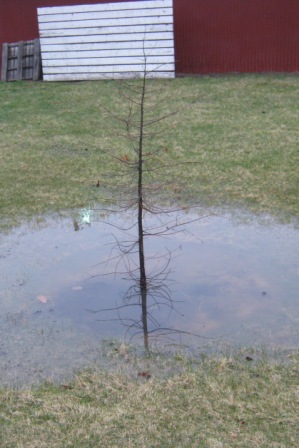April is turning out to be a soggy month for most of Michigan and our surrounding states. While most homeowners are inclined to hunker down indoors and keep an eye on their sump pumps on these dark, dreary days; our current run of wet weather is a good opportunity to take a stroll around your property and make some notes. In particular, note any areas where water is accumulating.
Poor drainage is one of the most common sites factors that limit landscape tree and shrub survival and growth. Sites that retain water for more than a day or too after rains stop are especially problematic. The challenge with wet areas is we usually wait to plant trees and shrubs until things are high and dry and it’s easy to forget where the wet spots are.
There are two primary strategies for establishing healthy trees and shrubs in flood-prone spots. First, determine if the problem can be corrected. In some cases homeowners may be able to re-direct water flow from downspouts or other sources to keep water form accumulating in one spot. Again, these kinds of problems are easiest to spot if you go out when it’s raining. Re-grading the area or installing drain tiles are other options but these are usually require skills and equipment beyond the average do-it-yourselfer.
If correcting the drainage issue is not an option, the second strategy is to plant trees or shrubs that are tolerant of flooding. Plants vary widely in their tolerance of soil flooding and, not surprisingly, trees and shrubs that grow naturally along riverbanks and other low areas are usually the most tolerant.

This low spot in my yard was a good site for a Baldcypress
There are numerous resources on flood tolerant trees and shrubs on the web. Two of the better resources are from the Morton Arboretum and from Cornell University. Please note the Cornell guide is a large (>6 MB) .pdf file.

These Michigan holly (Ilex verticullata) I planted a couple of years ago a doing fine even though they are periodically flooded each spring.
Wet areas on your property do not have to be a ‘dead zone’, but establishing trees and shrubs in low laying areas takes some planning. The first step in the process is assessing your site and identifying the problem areas. The best way to do this is to put on a raincoat and take a walk in the rain.
My problem is sandy soil that occasionally floods (the city has an easement to use part of my backyard when the detention pond next door overflows). The soil is so porous it bubbles when it floods like a dry plant in a bucket of water. In the summer, we get as much rain as the Sonoran Desert.
If you can recommend a tree that will take bone dry with occasional winter flooding I’d be grateful. There
is a spruce that seems to be doing well, but I don’t like spruces enough to plant more. They get spruce gall.
Hi Deirdre:
Deciduous conifers often work well in the situation you describe. Baldcypress, dawn redwood and larch can all handle some winter flooding but dry conditions in the summer as well.
Deirdre, I have two suggestions for you: (1) Visit the Washington Park Arboretum. They have a number of plants that get flooded on occasion, and perhaps there are some ideas there. (2) Go to the Miller Horticulture Library at CUH and ask for their tree selection books that are based on environmental conditions. They should have some – if they don’t, look at the wetland restoration books for tree selection (you want facultative wetland species, not obligate).
Here’s another suggestion from a 1993 study: sweetbay magnolia (Magnolia virginiana L.) was found to perform well under flooding and drought conditions.
River Birch (Betula nigra) is one of my favorites. OK with wet feet, plus the Winter interest aspect, and resistant to Bronze Birch Borer.
http://franklincountymgs.blogspot.com/2013/02/plants-with-winter-interest-part-12.html
Please let me know if you’re looking for a writer for your blog. You have some really good articles and I think I would be a good asset. If you ever want to take some of the load off, I’d really like to write some articles for your blog in exchange for a link back to mine. Please shoot me an email if interested. Kudos!